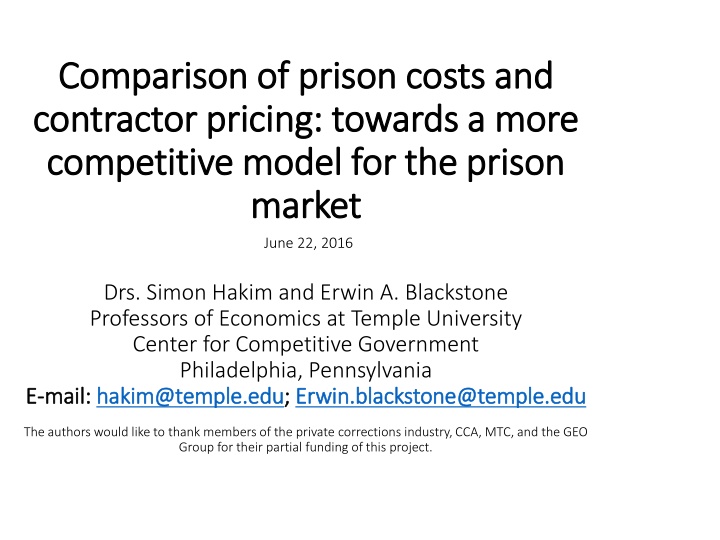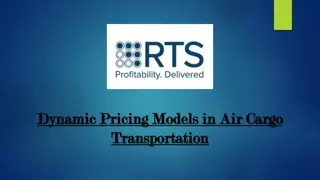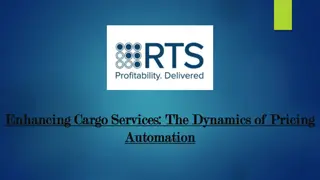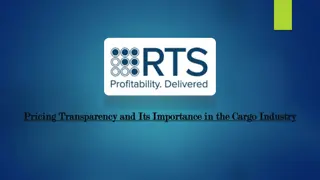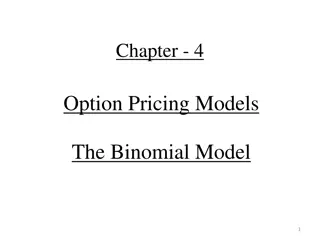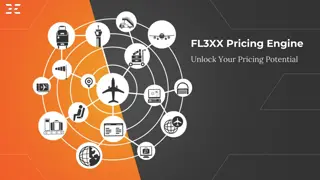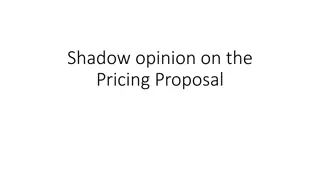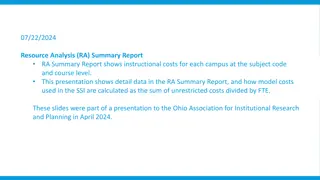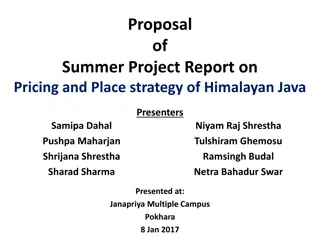Analysis of Prison Costs and Contractor Pricing for Competitive Model
Analysis by Drs. Simon Hakim and Erwin A. Blackstone of Temple University focuses on comparing avoidable costs in public and private prisons, emphasizing competition to drive prices down. The study delves into the principles of analysis, avoidable costs, performance metrics, and reasons for considering private contractors. It highlights the importance of detailing contracts to ensure performance on par with state prisons.
Download Presentation

Please find below an Image/Link to download the presentation.
The content on the website is provided AS IS for your information and personal use only. It may not be sold, licensed, or shared on other websites without obtaining consent from the author.If you encounter any issues during the download, it is possible that the publisher has removed the file from their server.
You are allowed to download the files provided on this website for personal or commercial use, subject to the condition that they are used lawfully. All files are the property of their respective owners.
The content on the website is provided AS IS for your information and personal use only. It may not be sold, licensed, or shared on other websites without obtaining consent from the author.
E N D
Presentation Transcript
Comparison of prison costs and Comparison of prison costs and contractor pricing: towards a more contractor pricing: towards a more competitive competitive model for the prison model for the prison market market June 22, 2016 Drs. Simon Hakim and Erwin A. Blackstone Professors of Economics at Temple University Center for Competitive Government Philadelphia, Pennsylvania E E- -mail: mail: hakim@temple.edu hakim@temple.edu; ; Erwin.blackstone@temple.edu Erwin.blackstone@temple.edu The authors would like to thank members of the private corrections industry, CCA, MTC, and the GEO Group for their partial funding of this project.
Principles of Analysis Comparison of pubic and private prisons is based on avoidable costs for the public sector against the price charged by contract operators and on the performance of the two. Cost to the contract operators is irrelevant. However, the more competition that exists the lower the price, approaching normal profits. The costs for the public sector should be determined as AVOIDABLE when shifting from monopolistic to competitive industry. Avoidable costs depend upon the reason for the shift to a competitive setting.
Avoidable Costs When a contractor operates an existing prison owned (and substantially renovated) by the state, avoidable costs are merely the operating or short run costs. When inmates are housed in a contractor owned or acquired from government facility, avoidable costs include also all capital related costs. Avoidable costs also include deferred or obligated future payments; not only out-of-pocket expenditures. Thus, underfunded pensions and retiree healthcare committed amounts must be included and not merely those actually paid out. Avoidable costs should include resources saved even if government chooses not to transfer them to other uses or become implicitly unemployed. Avoidable costs should include resources used by the prison that other state agencies provide under their budgets and are now conducted by the contractor.
Performance Comprehensive comparison of public and contract prison includes avoidable costs and performance. Evidence suggests that contracts with private contractors could be detailed enough and include quantitative measures to assure performance at the level and quality of state prisons. Government regulation & oversight can assure required performance. As more public and private entities are involved, competition substitutes for some gov t oversight.
Reason 1 Overcrowding requires that the long run avoidable costs be compared against the contractor s price.
Overcrowding Avoidable Costs Whenever overcrowding exists, the statutory requirement is less relevant since the overcrowding has to be alleviated in a timely fashion. California is a classic example of the cost encountered by failing to avoid substantial overcrowding and because private prisons are prevented from operating in the state. Overcrowding requires that the long run avoidable costs be compared against the contractor s price. The long run costs are appropriate because the state avoids building its own prisons.
Overcrowding: lower costs but Diminished Performance Overcrowding as in California and Ohio reduces both the short and long run costs per inmate per day however at the same time diminishes the quality of incarceration and security of inmates and correctional officers. Clearly, the overcrowding reduces the state per inmate costs compared to the private contractor s price at the facility s designed occupancy rate. This means that in the case of overcrowding state costs are biased downwards.
Reason 2 The long run consideration is relevant when the state owns old prisons that need major renovations, prisons that are subject to demolition because of age or condition, or when the state faces difficulties in raising capital. When inmates are transferred to private facilities cost should be estimated for the long run.
Reason 3: Savings Savings in operating costs when shifting to competitive contract operators
Reason 3 Statutory requirements in some states mandate savings of at least five to ten percent in order to contract out to private operators. The states usually do not specify whether the short or long run costs are considered. Also, avoidable state prison costs are often imposed on other agencies within DOCs and on other departments of state government which are often not measured and thus not included in the cost calculations. These costs are often not included in the state s calculations of cost per inmate per day. Clearly, these omissions establish artificially lower costs for state run prisons than the real value. Pensions and Retiree healthcare costs are below necessary level.
Reason 3 In cases like Florida and Mississippi, the contractor manages existing state-owned prisons. Thus, short run avoidable costs are relevant. In Kentucky and Oklahoma, the inmates are transferred to privately owned prisons. Thus, long run avoidable costs are relevant. Texas uses both types of contract prisons. Thus, short run avoidable costs are relevant when state-owned prisons are used, and long run costs are appropriate when private prisons are used.
Reason 4 Selling state prison to contract operation
Reason 4 contracting out by selling a state prison to a private operator generates an immediate lump sum amount for state coffers. This occurred in Ohio, which sold the Lake Erie Correctional Institution to a private contractor in order to narrow a state budgetary deficit.
Savings from Contracting Out STATES SHORT RUN AVOIDABLE COST SAVINGS LONG RUN AVOIDABLE COST SAVINGS Arizona -1.00% - 8.01% 14.25% - 22.34% California 29.43% - 57.09% 32.20% - 58.37% Florida 7.00% 17.67% Kentucky 9.43% - 20.88% 12.46% - 23.50% Maine 47.40% (estimated) 49.15% (estimated) Mississippi 8.69% 25.27% Ohio 4.14% - 13.44 20.28% - 26.81% Oklahoma -2.16% - 29.23% 16.71% - 36.77% Tennessee 17.32% 17.32% Texas 37.39% 44.95%
Saving Per Inmate Per Day Long Run Public Sector Cost and Savings $180.00 $160.00 $140.00 $120.00 $100.00 state $80.00 private $60.00 $40.00 $20.00 $0.00 TX TN BOP/GAO AZ AZ OH OH OK OK OK ME MS MS CA CA FL KY KY KY KY
Performance At least equal and often superior performance to state prisons is required for private prison contractors. For example, contractors in Florida performed above the state level in training and educating inmates, which could be attributed to competition among contractors and the desire for contract renewal. Interviews with state DOCs examined in this study reported that their contracts all mandate performance levels for private operators. Further, DOCs closely monitor adherence to these and other contract requirements. Additionally, private prisons are often required to meet the established standards of the American Correctional Association (ACA), which is the independent association of the corrections industry, and penalties can be and are frequently imposed for performance violations.
Findings A major finding from the cost analysis and interviews with state leaders and stakeholders is that competition yields savings and better performance across the prison industry. The economics of industrial organization demonstrates the important benefits derived from the presence of even a small competitor in an otherwise monopolistic market. In this case, even though private contractors comprise less than seven percent of the industry, they have generated substantial competitive benefits.
Sources for Savings from Contracting Out These benefits emanate from two sources. First, as more contractors compete, the prices are lower, and the performance is better. Likewise, when private prisons become an available option, efforts are made by public prison managers to lower costs, and wages demands by employees are constrained, since public employees realize that the legislature might favor private corrections as a more cost effective option. Further, the greater the competition, the more managerial and technological innovations are introduced in both the public and private segments of the industry. Interestingly, in several states where both public and private contract prisons operate, there was cooperation, mutual learning of new technologies, joint training, and adoption of efficient management practices.
Sources of Savings from Contracting Out Flexibility Contractors are more flexible in hiring (e.g. use of part time), purchasing (e.g. use of discount on volume or taking advantage of buying opportunities), hiring-laying off, tailoring wages to labor market conditions, pay change for merits/under performance, and shifting management.
Sources of Savings from Contracting Out Labor costs: labor costs were in the range of 43 to 71 percent of total costs. In general, contract prisons pay comparable wages but somewhat less in retirement benefits. For example, Ohio private correctional officers are paid $1 less per hour. In Oklahoma in 2012, the beginning base salary for a correctional officer was $2,153 per month at the public Northeast Oklahoma Correctional Center. A comparable beginning private correctional officer at the Davis Correctional facility earned $2,068 per month, 3.95 percent less than a public officer. Our interviews with state DOC officials revealed that, on occasion, private correctional officers were paid higher wages but lower pensions.
Sources of Savings from Contracting Out In California where until 2013 only private community correctional facilities operated within the state, the wages and benefits package in the correctional public sector compared to other states is high. The starting minimum salary for public correctional employees in 2008 was $3,774 per month, and some officers earned more than $73,000 a year. The California State Auditor reports that during fiscal year (FY) 2007 2008, beginning correctional officers were paid an average of $50,739 excluding any overtime. The annual pension contribution by California, including new officers, was $12,000 for FY 2009 2010. This was $4,000 more than other state employees received. California has 30,000 unionized correctional officers and, each year, 130,000 candidates apply to become correctional officers
Sources of Savings from Contracting Out Pensions: Private contractors typically offer workers matching contributions, or defined contribution, up to 5 percent of their salaries for their 401k accounts, which aligns with other private industries. Under this method, the market risk is borne by the employee. In fact, many workers choose not to contribute their share and thus lose the employer s contribution. State employees, on the other hand, have defined benefits which shift the risk to the employer. Defined contribution plans require the employer to contribute the specified amount in a timely fashion. A state s defined benefit method enables non-timely or insufficient contributions which is a significant cause for the underfunding problem.
Sources of long Run Savings A prison facility has limited alternative uses, capital costs are high (beyond the financing ability of most states), and the expected life span is long. At the same time, demand for prison space fluctuates and is expected to drop in the near future, leaving some public prisons vacant. The existence of private prisons enables DOCs to avoid building new prisons when demand is high and prevents waste of these facilities when demand declines. This is a major long term cost savings that is not considered in the statutory calculation of the avoidable costs by states.
Why are contract savings so high? Calculations for public costs did not follow the concept of avoidable costs. Missing short run costs because of unavailable and non- immediate out-of-pocket spending. These costs Include Indirect to DOC and other government agencies (e.g. sheriff office. indirect costs range from $3.72 per inmate per day to $6.64 per inmate per day), hierarchical, underfunded pensions and retiree healthcare. Missing long run costs including construction, planning, land acquisition, interest on bonds, depreciation, and related administration.
Recommendation: Managed Competition End to government monopoly in corrections. Existing state prisons are periodically auctioned out for operation. Public and private entities are allowed to bid including existing state employees. Length of contract is longer the larger the investment required from the contractor in improving the facility aimed to recover the investment.
Recommendation: Managed Competition This study points to a possible moderate change that could encourage even greater competition and thereby achieve more efficient delivery of existing corrections services: Introduction of the model of managed competition where public employees, as well as private contractors compete for a contract of operating existing state prisons. Thus, all interested contractors have an incentive to search for managerial and technological innovations and offer the services at competitive prices.
Benefits of Managed Competition State legislators have established seemingly arbitrary levels of required savings of five, seven, and ten percent. It is not clear why the percentages differ or what is the basis is for these levels of savings. The bidding by contractors often just approaches the statutory requirement and, indeed, high state required percentage of savings may discourage bidders and be counterproductive. It would be more effective to allow competition to determine the price. By instituting managed competition where the public sector competes on a leveled playfield with the private sector, the market determines the savings. In such a case, the complicated calculations of what cost items should be considered as avoidable and how to measure these costs becomes unnecessary. Managed competition has worked for many local public services, and there is no reason why it cannot be successfully implemented for the prison industry. Our suggested managed competition model is relevant for managing existing state prisons.
Benefits of Managed Competition The more public and private entities compete for prison management: the lower the price, approaching normal profits for contractors the better the performance in order to keep the existing contract and gain future contracts the greater the efforts by contractors to save in order to stay in business: the more technological and managerial innovations result. increase utilization of idle cells. Auctioning could be applied also for individual inmates that enter the system.
Benefits of Managed Competition Contracts should specify desired outcomes or performance and refrain from requiring what inputs to use or the method of production. Contractors should have the freedom to decide how best to meet the required outcomes. Obviously, contracts could be difficult to enforce when outcomes cannot be quantified. Our discussions with state correctional executives suggest that DOC contracts can specify the minimum performance levels required from the contractor that wins the bidding. Also, the private prison industry already includes a sufficient number of firms that compete across the United States. Thus, in each state where the legislature allows contracting out prisons, some existing state prisons could be auctioned as a managed competition model for a sufficient time period to encourage contractors to devote the appropriate resources for innovation and improved performance. This extension of competition could obviate to some degree the necessity for detailed contract specification and monitoring efforts.
Acknowledgements The authors thank the officials in the state corrections departments, state legislators, and state oversight agencies, as well as relevant federal officials, who provided the data and interviews used in this research. We also thank Corrections Corporation of America, GEO Group, and Management and Training Corp., members of the private corrections industry, for their partial funding of this project. Last but certainly not least, the authors gratefully acknowledge the helpful referees comments that have significantly improved this study through peer review. Any omissions or errors are the responsibility of the authors. The report has been refereed and published as a Policy Report by the Independent Institute of Oakland Ca. See, http://www.independent.org/pdf/policy_reports/2014-06-30- prision_break.pdf
